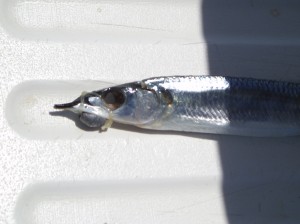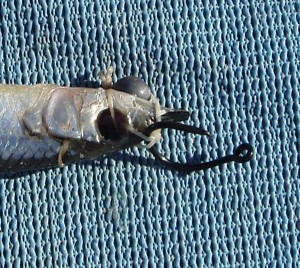Swim a Circle
Dr. Ken Neill, III
published in The Fisherman
We know that fishing with circle hooks is better for the billfish that we catch while using normal, drop back techniques. In addition to this, there are times when we are required to fish with circle hooks, either by government regulations or by tournament rules. For these reasons, anglers have come up with a number of ways to rig ballyhoo with circle hooks. Many ways have been used to rig a ballyhoo to skip with a circle hook. A naked, skipping ballyhoo is a wonderful billfish bait but my absolute, favorite bait for white marlin is a naked, swimming ballyhoo.
To get a ballyhoo to swim with a J-hook, the classic split-bill rig is used. Trying to rig a split-bill ballyhoo with a 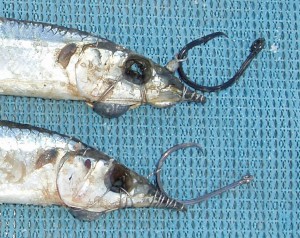 circle hook does not work very well so other rigging techniques have been developed to get a ballyhoo to swim with a circle hook. One way is to use a swivel attached to the head of the ballyhoo. The circle hook is run through the ring of swivel. This rig swims great and it is an excellent fish catcher. A problem with it is that the ring on the swivel and the hook have to be perfectly matched. If the ring is too small, you cannot get the barb off the hook to slide through it. If the ring is too big, you risk the hook sliding out of the ring during your drop back. The solution to this is to get rid of the swivel. You can just use a loop in rigging wire in place of the swivel. The rigging wire is attached to the bend in the hook via a haywire twist. The loop is loose enough to allow the circle hook to move but small enough so that it cannot slide over the shank of the hook. This is another great rigging technique which also has a problem. Sometimes, the rigging wire will fatigue and break. This typically will happen at just the wrong moment.
circle hook does not work very well so other rigging techniques have been developed to get a ballyhoo to swim with a circle hook. One way is to use a swivel attached to the head of the ballyhoo. The circle hook is run through the ring of swivel. This rig swims great and it is an excellent fish catcher. A problem with it is that the ring on the swivel and the hook have to be perfectly matched. If the ring is too small, you cannot get the barb off the hook to slide through it. If the ring is too big, you risk the hook sliding out of the ring during your drop back. The solution to this is to get rid of the swivel. You can just use a loop in rigging wire in place of the swivel. The rigging wire is attached to the bend in the hook via a haywire twist. The loop is loose enough to allow the circle hook to move but small enough so that it cannot slide over the shank of the hook. This is another great rigging technique which also has a problem. Sometimes, the rigging wire will fatigue and break. This typically will happen at just the wrong moment.
While helping Dr. John Graves of the Virginia Institute of Marine Science with his study of white marlin, I have been fortunate to spend a fair amount of time fishing with some of the best captains and mates in the world. These guys can rig a ballyhoo anyway you can think of and we have tried most of them. While fishing off of Venezuela, we learned another circle hook swimming rig. It has become my favorite for a number of reasons. It is simple to rig. It does not matter what hook you use which was a real advantage when we kept changing hooks as part of the study. Hooks do not fall out during drop back and there is no wire to fatigue and break.
Prepare your ballyhoo how you normally prepare it for rigging. Remove the eyes. You can snip off the pectoral fins. I usually leave them alone as long as they are positioned normally along the body. If they are stuck forward, I cut them off. Cut or break the bill off square leaving about ½ inch of bill remaining.
To rig your ballyhoo you simply need a piece of waxed rigging floss about twenty inches long and an egg sinker of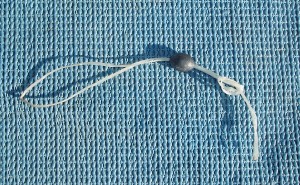 1/4 to 1/3 ounce to use for a chin weight. Fold the floss in half and tie an overhand knot at the tag end. Thread the loop end through the egg sinker and you are ready to rig your ballyhoo.
1/4 to 1/3 ounce to use for a chin weight. Fold the floss in half and tie an overhand knot at the tag end. Thread the loop end through the egg sinker and you are ready to rig your ballyhoo.
 Slide the loop over the head of the ballyhoo. Pass the floss under the gill plates on both sides. Position the egg sinker under the ballyhoo’s chin. Slide the tag end of your floss over the bill. Pull the tag ends apart and the knot will slide down, snug it up. Make sure the sinker is centered and the knot ties the mouth closed.
Slide the loop over the head of the ballyhoo. Pass the floss under the gill plates on both sides. Position the egg sinker under the ballyhoo’s chin. Slide the tag end of your floss over the bill. Pull the tag ends apart and the knot will slide down, snug it up. Make sure the sinker is centered and the knot ties the mouth closed.
Now, pass each tag end through the eyes from opposite sides and form another overhand knot with the tag ends 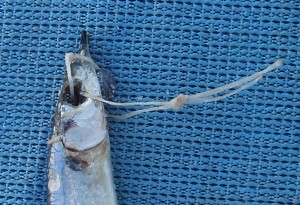 under the ballyhoo. Pull the tag ends apart and snug the knot down behind the sinker. Form another overhand knot and snug it down again. Cut off the tag ends and you are ready to go fishing.
under the ballyhoo. Pull the tag ends apart and snug the knot down behind the sinker. Form another overhand knot and snug it down again. Cut off the tag ends and you are ready to go fishing.
You now have a chin weighted ballyhoo with a harness. To fish it, simply slide your hook behind the harness where the knot is sitting on top of the ballyhoo’s mouth. You can rig a bunch of these ahead of time and it does not matter which circle or even a J-hook that you are going to use. Ballyhoo rigged like this have proven to be very effective on sailfish, white marlin and blue marlin. It is 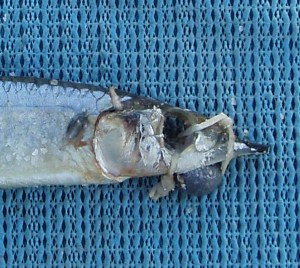 easy to rig and it swims well. The next time you are fishing for billfish, give it a try.
easy to rig and it swims well. The next time you are fishing for billfish, give it a try.

